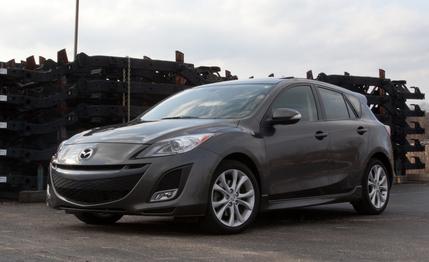 Long-Term Road Test Wrap-Up
Long-Term Road Test Wrap-Up
Date: April 2011
Months in Fleet: 17 months
Current Mileage: 40,037 miles
Average Fuel Economy: 26 mpg
Range: 413 miles
Service: $403
Normal Wear: $0
Damage and Destruction: $6170

With a 10Best nod fresh under its belt, a 2010 Mazda 3 hatchback entered our long-term fleet in the fall of 2009 to much anticipation. A spunky five-door economy car boasting talkative steering and a tight chassis, the second-generation 3 embodied nearly everything we’d want in an everyday car: poise, practicality, ample power, low maintenance, and a six-speed manual transmission.
At the time, the new-for-2010 Mazda 3 was the top of its class, besting the then-also-new Kia Forte SX and Volkswagen Golf VI in a three-way comparison test. Positive comments populated the logbook from day one, and our car quickly proved adept at tackling everything from daily highway slogs to twisty mountain passes.
Loaded Up
With a range-topping, turbocharged 2010 Mazdaspeed 3 also en route to our long-term garage, our pick for a standard-fare 3 was an s Grand Touring model with nearly all the fixin’s: standard leather seating, 17-inch aluminum wheels, dual-zone climate control, and bixenon headlights (the five-speed automatic was an $800 option we decided to live without). The 2.5-liter four-cylinder’s 167 hp and 168 lb-ft of torque paled in comparison with the Mazdaspeed’s direct-injected 2.3-liter turbo mill (263 hp, 280 lb-ft) yet still offered good passing power and flexibility with the manual gearbox.
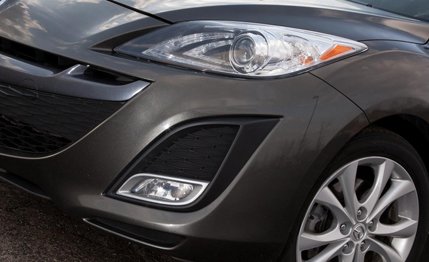
The standard 3 starts at $16,095, and the least-expensive hatch is $20,435. Our five-door GT’s $22,750 base price raised eyebrows from the onset. The addition of the $1195 Technology package (navigation, keyless entry, satellite radio, perimeter alarm, and pushbutton start); another $1395 for a package bundling Bose audio, a power sunroof, and a six-CD changer; and $250 in dealer accessories blew the price to $25,590. That figure smacks of excess for a small car with a big smiley face across its grille. “Still love this car, but 25 grand is pushing it really hard for something in this class,” noted executive online editor Erik Johnson.
In spite of its impressive list of features, our car was lacking in certain areas. The miniature screen for the navigation system drew repeated criticism for its low resolution and steering-wheel-mounted controls. (One editor did come to its defense, but his was among few voices in support of the layout.) An aux input offered basic connectivity, but the absence of a USB port in a car with a youthful customer demographic and a heavy price tag irked more than a few music buffs. A dearth of storage cubbies for cell phones and such also frustrated some, as did the convoluted labeling of the buttons on the center stack. Taller pilots took issue with the sunroof—it gobbled valuable headroom—and a steering column that didn’t telescope far enough, resulting in an outstretched-arms driving position. Meanwhile, passengers banished to the back seat found comfort in short supply if those up front weren’t cooperative. Although the styling of the second-gen 3 was slow to find supporters around our office—we eventually grew at least tolerant of it—the dark Graphite Mica paint of our tester helped mask the car’s pronounced grin.
Earning Its Keep
Complaints aside, the fact that it took longer than our usual 12 months to reach 40,000 miles is more a result of an unfortunate accident (more on that later) and other fine long-termers we had in the fleet than a knock against the 3’s packaging or ability to swallow miles with ease. “Obviously, the 3 is not a rocket, but it has great steering, great ride-and-handling balance, and enough grunt to move you when needed,” stated associate online editor Jon Yanca. Many agreed.
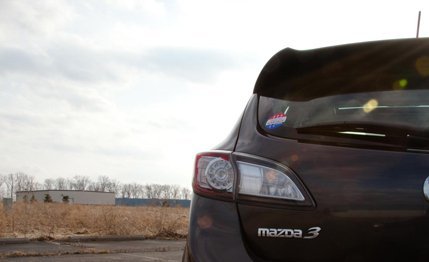
We also shared initial praise for the car’s quiet, composed ride, slick shifter, and light clutch, the latter a pleasant change from the hair-trigger third pedal in the Mazdaspeed 3. The absence of the Mazdaspeed’s notoriously aggressive torque steer was welcome, too.
At the end of its 40,000 miles, with Yokohama Avid S34 all-seasons reinstalled in place of its Michelin X-Ice Xi2 winter rubber, the car posted a 7.4-second run to 60 mph, 0.2 second quicker than when new. An improvement of 0.1 second and 1 mph over the quarter-mile resulted in a pass of 15.7 at 89 mph. Roadholding improved by 0.01 g, to 0.86, and an additional foot in the 70-to-0-mph braking test made for a still-solid 169-foot stop. Despite a significant amount of daily flogging, the car ended its stint averaging 26 mpg overall, right in between its city/highway ratings of 21/29 mpg.
Nothing’s Perfect
A couple of issues arose not far into the test, though, and stayed with us until the car’s departure. At about 10,000 miles, the electronic controls for the driver’s seat began to stick, making fore-and-aft adjustments troublesome and preventing height adjustments altogether. A $795 seat-track assembly was replaced by the dealer under warranty and temporarily cured the problem. But when the malfunction reappeared several thousand miles later, Mazda determined a broken trim piece and clip on the seat were affecting the switch. Had the 3 not still been under warranty, this repair would have tallied an easier-to-swallow $150.
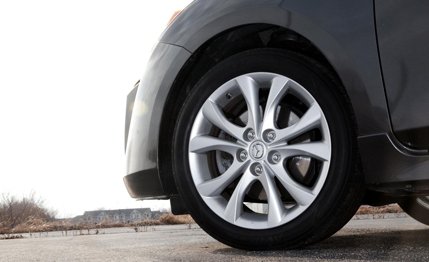
Our other concern was the once-praised clutch pedal, which lost much of its feel by 20,000 miles and became a real irritant toward the end of the car’s stay, making smooth launches and one-two shifts difficult at best. Although the clutch survived our punishment without needing replacement, its problem undoubtedly will need to be addressed soon.
Sudden Impact
Service costs for our Mazda 3 totaled $403 for six scheduled visits, with a $103 oil-and-filter change, inspection, and tire balancing at 37,000 miles being the only service stop since our last update. Vehicle wear is covered under warranty, but bent wheels are not, and our Mazda dealer charged $63 to tell us that, yes, the wheel we suspected was bent did need to be replaced. A new 17-incher cost $538.
But what really emptied our pockets—and sidelined the car for weeks—was one staffer’s run-in with a Lincoln Navigator during a winter excursion to Chicago, which resulted in significant body and structural damage to the front of the Mazda. After mending the front bumper, radiator support, and passenger-side fender, door, and front suspension, the bill came to a painful $5562. We spent an additional $70 on a return visit to the dealer to have the windshield-washer lines reinstalled properly. Add to that the cost of our pothole-ravaged wheel, and our out-of-pocket expenses totaled nearly $6200.
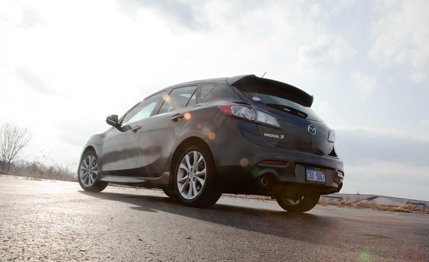
Still a Sweetheart
The Mazda 3 was recently relegated to runner-up status by a 2012 Ford Focus in our latest C-segment gathering with a Chevy Cruze, Hyundai Elantra, and Volkswagen Jetta. The 2012 Honda Civic is out, as well, and many of these new or updated models now offer a competitive, if not stronger, combination of technology, refinement, and overall packaging than the Mazda did when new.
What those vehicles don’t have, however, is the 3’s unyielding connection to the road and its willingness to heed the driver’s commands with enthusiasm. That playfulness is the Mazda 3’s meal ticket, and the car is refreshingly honest about everyday driving enjoyment. The updates for the 2012 Mazda 3 are largely focused on fuel economy and, thankfully, should do little to impact overall performance. The problems we experienced—at least the ones that weren’t our fault—were relatively minor, and we agreed that the 3’s strengths will not suit everyone. But for those in need of practical transportation who like to wear Pilotis for the daily commute, the Mazda 3 remains one of the best small cars on the market.